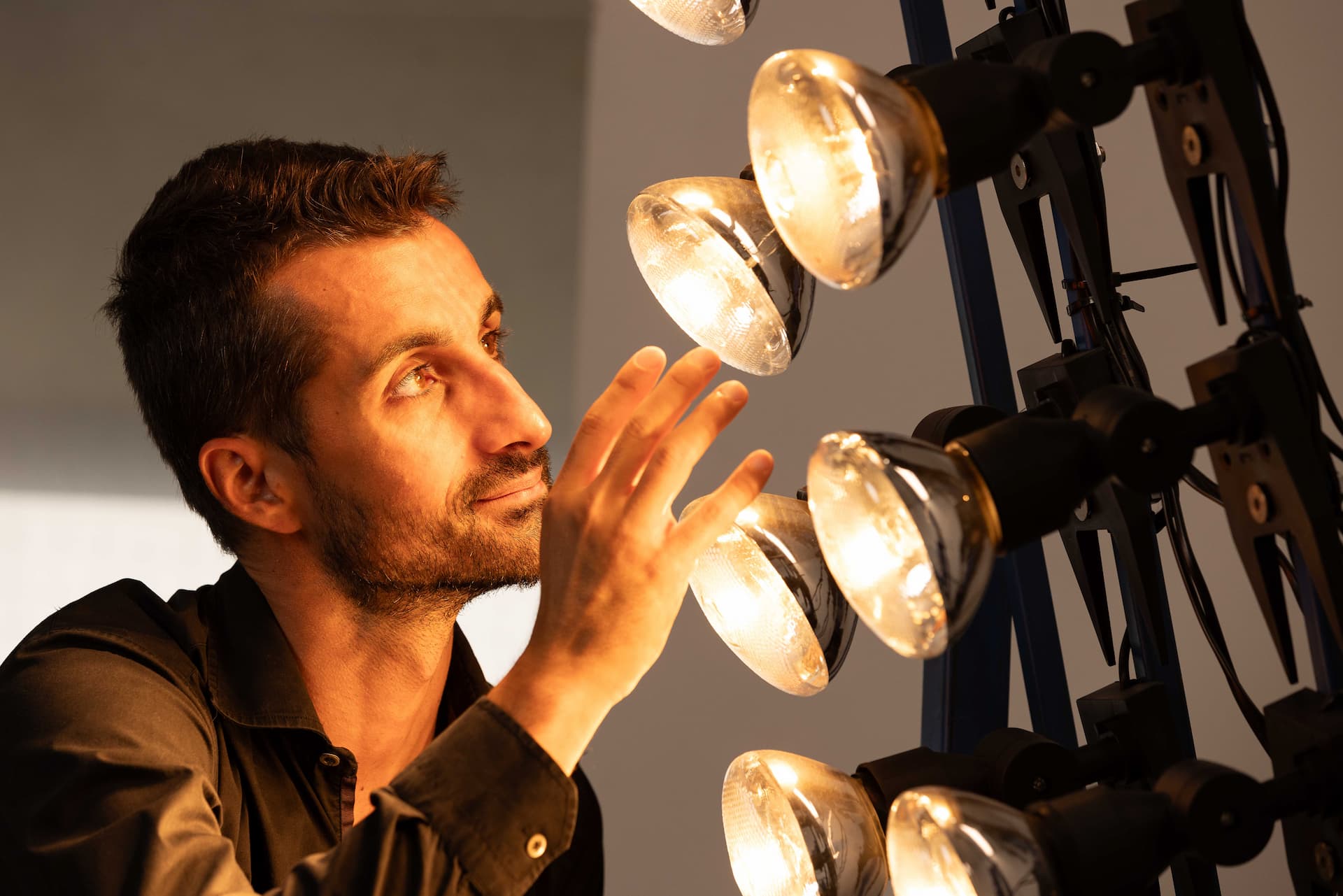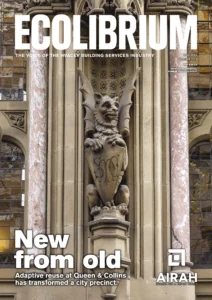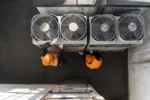Cool comfort

Federico Tartarini is Senior Research Associate at the Heat & Health Research Incubator, Faculty of Medicine and Health, at the University of Sydney. And soon he’ll be starting a new position as a Sydney Horizon Fellow, Senior Lecturer at the School of Architecture, Design, and Planning, also at Unisyd. Ecolibrium editor Matt Dillon asks the winner of the 2023 AIRAH Future Leader Award about the connection between indoor environment and thermal comfort, productivity, health, and well-being.
Ecolibrium: Do you have a specialty? How did this come about?
Federico Tartarini: My main research areas include human thermal comfort, indoor environmental quality, heating ventilation and air conditioning systems, cognitive performance, thermophysiological modelling, and the development of non-intrusive methodologies to monitor IEQ parameters. My research aims to develop occupant-centric solutions and tools to improve the performance of existing and new buildings.I am passionate about this field of research, since buildings consume about 40 per cent of the electricity produced and occupants drive this consumption. Hence, if we want to ensure that buildings are sustainable, efficient, and comfortable, we first need to understand the thermal needs and preferences of the occupants, and only then we can find innovative solutions to keep them comfortable, healthy, and productive while at the same time minimising energy consumption. Improving the building sector has a huge potential in fighting climate change.
Eco: How did an Italian researcher find his way to Sydney?
FT: During my master’s thesis in Italy, I did an exchange to Denmark. I loved that experience, so I decided to do another exchange overseas before starting to work in Italy. The University of Bologna had some connections with the University of Wollongong. I then contacted the former director of the Sustainable Buildings Research Centre at the University of Wollongong, Professor Paul Cooper, L.AIRAH.He welcomed me to his team, and I worked with him on my master’s thesis. It was great experience, and I fell in love with Australia. I then had to go back to Italy to complete my studies. But a year after, in 2014 I contacted Paul again and he offered me a chance to join his group as a PhD student. I then moved back to Australia.
Between 2019 and 2022 I lived in Singapore, where I worked with researchers from UC Berkeley on developing free and open-source tools and on personal comfort models. In 2022 I wanted to come back to Australia. This is when I saw a job opening at the Heat and Health Research Incubator, where I am currently working.
In 2023, I had the privilege of getting the USYD Horizon Fellowship, which will enable me to focus on my research for the next five years and remain in Sydney.
Eco: What are you enthusiastic about?
FT: I am enthusiastic about doing research on topics that have a broad impact – improving energy efficiency and thermal comfort in buildings is one of them. I am also passionate about developing free and open-source tools that people in the community, researchers, practitioners, and policymakers can use for free. Throughout my career I have had the great opportunity to work on many tools. Here is a list of some of the tools I’ve developed:
- HeatWatch – free web app that allows people to calculate their personalised heat health risk and provide cooling recommendations.
- SMA Extreme Heat Tool – free web app to predict heat stress when playing sport.
- pythermalcomfort – a Python package to calculate several thermal comfort indices.
- CBE Thermal Comfort Tool – an online tool for thermal comfort calculations and visualisation.
- CBE Clima Tool – an online tool for climate data analysis and visualisation
- Cozie application for Apple – smartwatch application for environmental quality satisfaction and physiological data collection.
Eco: Could you tell us about the HeatWatch application? How did you go about developing it, and why?
FT: Heatwaves pose a significant threat to human health in New South Wales and across Australia, claiming more lives than any other natural disaster.
In response, the Heat and Health Research Incubator at the University of Sydney, in collaboration with community partners, developed the HeatWatch application. HeatWatch allows users to estimate their personalised heat health risk based on factors such as the environmental conditions as well as their location, age, activity level, and clothing.
It also provides science-backed cooling strategies that are easily implementable. Its design and features are shaped by direct consultations with community members via focus groups, ensuring a user-friendly and practical tool for heatwave health risk management.
In recent times, heatwaves have become more intense, frequent, and prolonged – a trend that will escalate in the foreseeable future. As NSW’s population continues to grow and age, it is crucial to safeguard the most vulnerable from the detrimental health effects of extreme heat, reinforcing the importance of the HeatWatch application.
This work is funded jointly by the federal and NSW governments under the National Partnership Agreement on Disaster Risk Reduction.
Eco: What about the Python app?
FT: If you are a researcher or a professional working in the building sector, you may have encountered the need to assess the indoor thermal environment using models such as predicted mean vote (PMV), adaptive comfort, or standard effective temperature (SET). These models are based on standards such as ASHRAE 55, EN 16798, or ISO 7730, which provide the equations and the programming code to calculate them. However, these standards are not freely available, and the code is written in JavaScript or BASIC, which may not be convenient for Python users.
That’s why we developed pythermalcomfort, a Python package that allows you to calculate the most common thermal comfort and thermal stress indices in compliance with the main thermal comfort standards. So pythermalcomfort is the only Python package available on PyPI that contains a comprehensive list of validated thermal comfort functions.
You can use it to calculate:
- Whole body thermal comfort indices (e.g., PMV, adaptive models, SET)
- Thermal stress
- Physiological variables (e.g., sweat loss, skin wettedness, core temperature, skin temperature)
- Local discomfort (e.g., vertical temperature gradient, ankle draft)
- Clothing insulation (e.g., from outdoor temperature, from list of garments)
- Psychrometric properties of air (e.g., enthalpy, vapor pressure, dew point)
- Solar gain on people (e.g., effective radiant field, mean radiant temperature increment).
In short, pythermalcomfort is a powerful tool for conducting thermal comfort analyses. You can use it for educational, research, or industrial purposes. You can also integrate it with other Python packages or applications. For example, you can use it with pandas to analyse thermal comfort data, or with matplotlib to visualise thermal comfort results.
I am planning to continue to develop, maintain, and add new functionalities to the following applications:
- CBE Thermal Comfort Tool
- CBE Clima Tool
- Cozie for Apple and Fitbit
- Sports and Medicine Australia Extreme Heat Tool.
Eco: What do you like about your job?
FT: I love the flexibility of being able to work on what I am passionate about. I love being surrounded by bright and smart people who help you but at the same time challenge you intellectually so I can always strive to improve. I love that I can work on several free and open-source tools, and I can give back to the community since, in the end, my research is funded by taxpayers’ money.
Eco: What do you find challenging?
FT: Sometimes the workload is very high. Since there is always something new that can be done and many people come to me with very interesting projects, it is hard to say no, but at the same time the work keeps piling up. I then try to be as efficient as possible, so I minimise the time I waste on repetitive tasks.
Eco: Could you tell me about your “Fan first” strategy? Does a fan have to meet basic criteria before it is effective?
FT: Fan-first cooling is a strategy for staying comfortable in warm weather by prioritising electric fans over air conditioning (AC). It’s a more sustainable approach because fans use much less energy (10 per cent or less energy) than AC units, which helps reduce greenhouse gas emissions that contribute to climate change.
It works because you’re moving air, not chilling the room. AC cools the entire room by lowering the air temperature. Fan-first cooling, on the other hand, focuses on moving air across your skin.
This creates a windchill effect, making you feel cooler even if the overall air temperature stays the same. Think about how nice a breeze feels on a hot day!
Its effectiveness depends on aiflow and temperature and humidity. With airflow, the faster the air moves – think higher fan speed – the stronger the windchill effect and the cooler you’ll feel.
With temperature and humidity, fans work very well in hot and humid places. When the air is already saturated with moisture, air movement helps sweat to evaporate from your skin. Fans are also effective in dry conditions, but they should not be used if the indoor air temperature exceeds 40°C and the room is very dry. Luckily, these conditions are very rare in buildings, hence fans are quite safe to use in most conditions indoors.
Additional factors include personal preferences and health conditions.
Although many people like using a fan to keep themselves cool, as we have shown in many research projects, some people may find constant airflow from a fan uncomfortable.
And for people with certain health issues, especially older adults or those with heart problems, extreme heat can be dangerous. In these cases, AC might still be necessary during very hot weather.
Fan-first cooling saves money, is environmentally friendly, and is more accessible.
A study we did in Singapore showed that fan use in commercial buildings can reduce the building energy consumption by 32 per cent.
Eco: What would you most like that you don’t have?
FT: Being closer to my family and friends in Italy. Australia is a great place to live but it is very far away from Italy. I am very lucky since each year I can go back for almost a month to visit them, but I wish they would be closer.
Eco: If I wasn’t doing what I’m doing, I’d be…?
FT: An engineer, working on ways to produce electricity using renewables. However, when I was a kid I always wanted to be a farmer like my grandfather. Maybe one day when I retire from academia I will be a farmer.
Eco: Something people might be surprised to find out about me is…?
FT: That I love travelling, spending time outdoors, swimming, snorkelling, cycling, and hiking. I love being in nature and camping. This is what I try to do over the weekend. I also love to learn other topics during my free time like philosophy, history, astronomy, and physics.
Eco: What are you optimistic about?
FT: Despite all the issues we see in the news, the world is becoming a better place and people are more connected. I am optimistic that when we are faced with hard challenges, as a society we can overcome them. It would be better, though, if we would be more proactive in the face of global challenges.
I am also optimistic that the internet and artificial intelligence can bring about positive change and make education more equitable for everyone.

This article appears in Ecolibrium’s May 2024 edition
View the archive of previous editions
Latest edition
See everything from the latest edition of Ecolibrium, AIRAH’s official journal.





